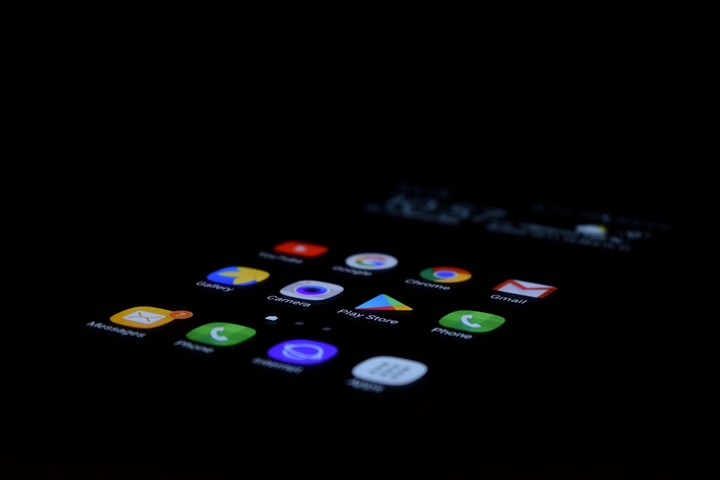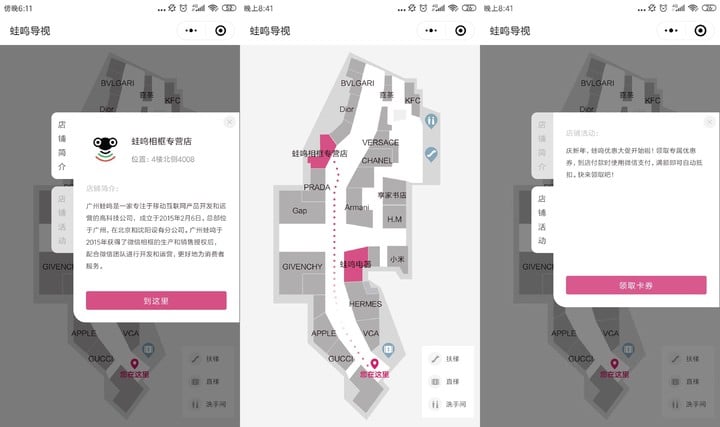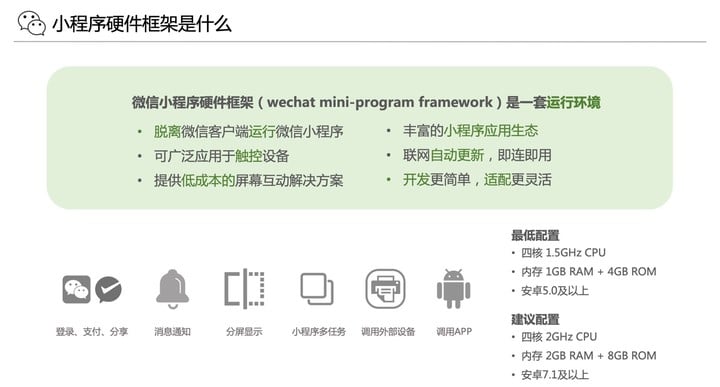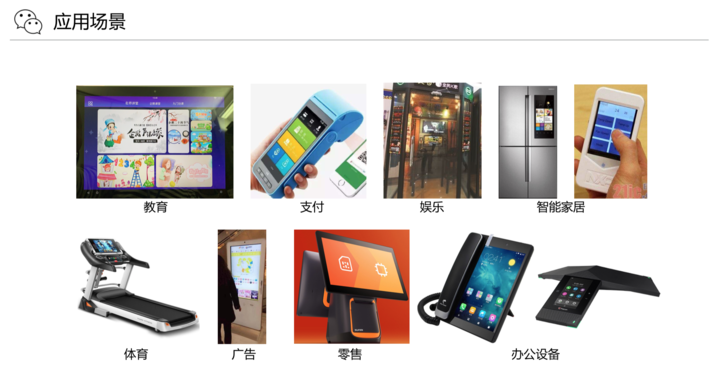We know this day is coming, but we are still amazed by how fast it comes and the silence beforehand.
On January 9, 2020, “WeChat Mini Program Hardware Framework” was officially released on WeChat Open Class Pro. According to the official introduction, this is a set of operating environments that allow hardware terminals to run WeChat applets without the WeChat client. Hardware developers only need to integrate the applet hardware framework access SDK and runtime APK to run applets smoothly on the hardware.
In the WeChat Open Class Pro at the end of 2016, when Zhang Xiaolong introduced the applet to the public for the first time, he explained that the applet is actually the product of the next generation Internet: smart glasses may be our daily life in ten years’ time. The equipment used, “I hope more that the glasses do n’t give me some procedures for installing applications, because that is very unnatural and inconvenient. I also want to see where my glasses are and the related applications. Where it is. “

The popularity of AR glasses may be far away, but 5G is near. With the efforts of some hardware manufacturers in the past few years, the penetration rate of IoT devices such as smart speakers, TVs, headphones, and smart homes has become higher and higher. In addition, many screen-equipped devices such as payment, retail, and advertising in business scenarios also have networking capabilities. Extend more on these devices with WYSIWYGService is something more in line with human interaction and usage habits.
Which industries can applet hardware framework bring changes to? What is its greatest value to users? What is the long-term plan for the applet hardware framework? We had an exclusive interview with the product director and technical director of the WeChat Mini Program hardware framework, and heard them answer everything about the Mini Program Hardware Framework.
What is the WeChat Mini Program hardware framework?
WeChat Mini-Program Framework, also called WMPF for short, is a set of operating environment that allows hardware terminals to run WeChat applets without WeChat clients.
How did this happen?
We know that WeChat applets can already be run on WeChat. This is the result of the WeChat technical team refactoring the WeChat client applet modules and decoupling the independent applet hardware framework SDK. Therefore, the developer ’s applet is therefore Can be run on the corporate WeChat end through the same set of code.
The newly released WeChat Mini Program hardware framework is different from the past Mini Program Hardware Framework SDK. It does not exist as an independent SDK, but contains the Mini Program Hardware Framework SDK and security hardening modules. app “form. The person in charge of the applet hardware framework technology explained that this is mainly based on security considerations, and third-party clients may contain uncontrollable risk modules.

▲ “Shell app” can provide a more secure operating environment
If you understand it in simple terms, the applet hardware framework is a “WeChat” that removes functions such as communication modules and circles of friends, or more precisely, it is a secure low-level environment for running applets.
At the same time, because it exists in the form of an app, the accessor of the applet hardware framework is actually a variety of smart devices. At present, the applet hardware framework mainly supports touch-screen Android smart devices, which can run WeChat applets directly after integration.
What’s the change?
I know that the program has experienced some Demo cases. A smart big screen placed in a large department store will display a schematic diagram of each store in the business circle. The entire interface is presented in the form of a small program. When I click on a store on the screen, the store information and navigation location are displayed on the screen , Click navigation to display the route from the current location to the target. If I want to view it on my phone, I can log in by scanning the code, open the same applet on the phone’s WeChat, and display the navigation route.
The smart big screen can also do more operations. For example, some shops have directly connected to their own applet. When the user clicks on the box of the shop, they will jump to the shop’s own applet and display the latest promotion information and brand. Mall, user profile, etc.
The operation of the small program on the smart big screen is exactly the same as that on the mobile phone, with only slight differences. For example, when the user logs in, collects cards, and pays on the big screen, he needs to cooperate with the mobile phone to scan the code.

▲ On the smart screen, the button of “Get Card” will become a QR code
At the same time, when users want to share the content they see on the big screen to their friends, they can also share the applet card to their friends or WeChat group by scanning the code.
In addition to the smart big screen, I know the program has also experienced devices such as service robots with screens, smart POS machines, treadmills, early childhood education tablets, and smart refrigerators. They all provide a consistent experience with WeChat, and can be used with WeChat. The combination of ecological and WeChat users.
The person in charge of the product of the applet hardware framework told the knowing program that the existing cases focus on business scenarios, early childhood education scenarios, smart homes, etc.
Compared with App and HTML 5, the applet hardware framework has a standardized software ecosystem, and has the advantages of easier development and more flexible adaptation. The applet hardware framework does not have high requirements for device configuration. The minimum configuration only requires a quad-core 1.5GHz CPU, memory 1GB RAM + 4GB ROM, and Android 5.0 and above. Most mainstream smart screen devices can support it.

WeChat announced that the Mini Program Hardware Framework project is now officially open for access. For hardware partners, it can be accessed through the following three steps:
1) Hardware registration is required at https://wecooper.weixin.qq.com.
2) Apply for “Mini Program Hardware Framework Module”. And connect the SDK and APK of the applet hardware framework.
3) Bind the applet that you want to run appId.
In addition, developers can view a more detailed introduction to the applet hardware framework in the official WeChat document: https://developers.weixin.qq.com/doc/oplatform/Miniprogram_Frame/
What is the value of the applet hardware framework?
The applet hardware framework can bring direct value to hardware developers.
In the past, hardware developers needed to customize their own development software. If they want to access more services, they need to develop in the form of apps and maintain maintenance and updates.
The applet hardware framework allows developers to greatly reduce development and maintenance costs. Developers no longer need to invest high costs to maintain and update apps, because applets can be directly connected to the cloud to update.
The more obvious benefit is that WeChat Mini Program Ecology already has very rich content and services. When hardware developers need more services, they can directly interface with appropriate third-party services. WeChat provides a small The method of program appid directly binds more applet solutions.

The person in charge of the applet hardware framework product tells the knowing program that, in an ideal situation, an experienced hardware developer can integrate the applet hardware framework very quickly. At the same time, if the current developer developed the Small programs can be directly tied to the hardware, and the entire process can even be completed in one day.
The ability to connect with WeChat has brought greater imagination to hardware developers: WeChat ecology can empower hardware, and through WeChat authorized login, you can accurately grasp user portrait information; through WeChat sharing capabilities, you can provide service content Fission dissemination within WeChat; service subscription notification messages can reach users in one step; payment card coupons can make users’ value more realizable.
Applet developers can also benefit from the applet hardware framework.
More intelligent hardware access to the applet hardware framework means that applet developers can get more traffic from offline scenarios and more devices; at the same time, it can achieve online and offline service convergence and traffic interoperability In addition, because of the cross-platform nature of the applet, the difficulty for developers to adapt to different hardware devices is also greatly reduced.

For merchants who want to expand service scenarios through intelligent hardware, if they choose the applet hardware framework, they can also directly access the rich applet application ecosystem; at the same time, the ability to connect with the WeChat ecosystem is also conducive to secondary access And fission spread.
There is an experiential case on the scene from the smart fixed line of a hotel owned by Wanda. The fixed phone in the hotel room comes with a screen, and several separate small programs provide cleaning, food delivery and other services. Users can use the phone Directly operate on it; in addition, it also integrates small programs such as nearby Wanda theaters, shopping malls, etc., to display business district information, movie tickets, etc. for users to use directly.
Of course, in the end, for users, an experience that is consistent with the operation and operation process in WeChat, also greatly reduces the learning cost.
What kind of application does the next generation Internet need?
When the applet was released at the end of 2016, Zhang Xiaolong regarded it as an application form suitable for the next generation Internet. In his view, a mobile phone is an extension of a person’s body, but a PC is not. Because a PC is fixed, it can bring people into a virtual world; but a mobile phone is like an extension of a human hand and can reach a larger world .
What is the next generation Internet behind smartphones? Zhang Xiaolong envisioned a future scenario: smart glasses become smart devices that people use every day. When people use glasses to view the surrounding information and want to reach services, they can achieve what you see is what you get. This is more natural than getting a service after touching the screen of a mobile phone. ,More Advanced.
The development of the applet seems to confirm Zhang Xiaolong’s assertion. In 2019, the Alipay applet was officially upgraded to the Ali applet. It uses the SDK to connect the Alipay applet and various applications in the Ali system. Online scenes provide point-and-click services; hardware manufacturers are also active, and Xiaomi and Huawei are actively promoting the extension of their fast applications to speakers, TVs, headsets, VR and other devices other than mobile phones.

For tens of millions of ordinary users, the form is not important, but consuming content and using services quickly and easily anytime, anywhere is always the first demand of users. The WeChat Mini Program hardware framework provides a solution that it deems to be the most suitable, and the mini program ecology and 1.1 billion active users who have restrained development in the past few years have provided it with great advantages.
At the end of the interview, when the program asked about the 2020 target, the product leader of the Mini Program Hardware Framework project did not disclose the specific figures, but she said that the bigger task at present is to tell more developers that they can Run your own applet on a smart screen outside your phone.